1st Thessalonians and the Ministry of Paul
Mike Ervin
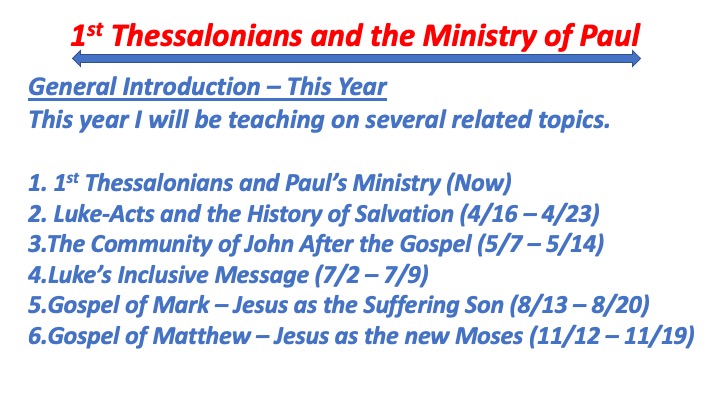



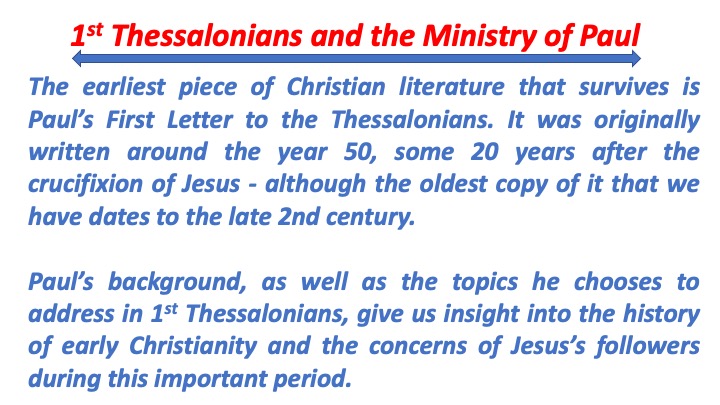
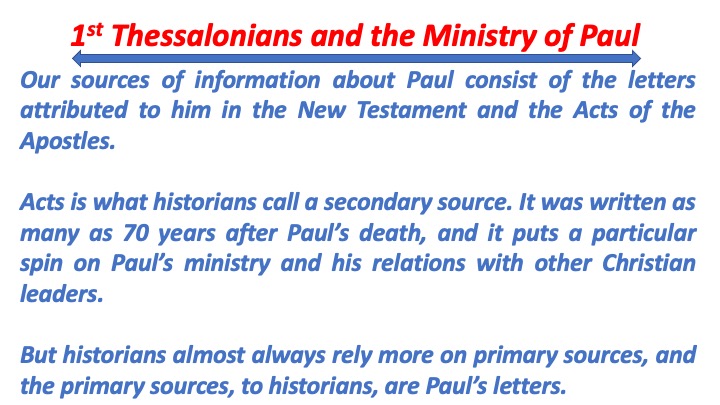
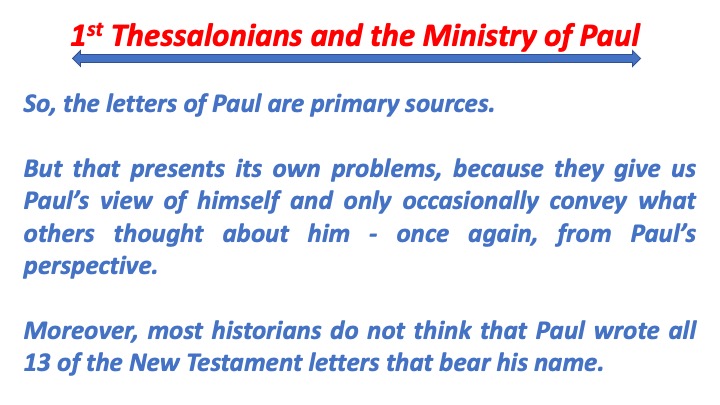


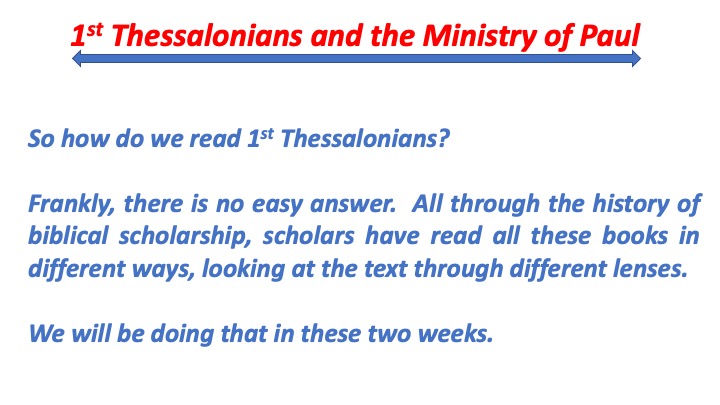
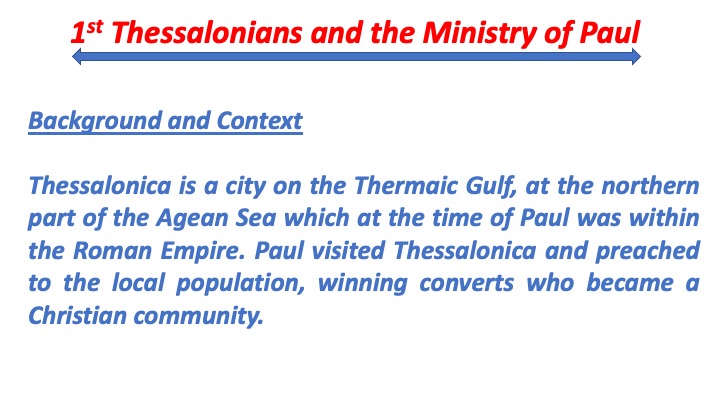

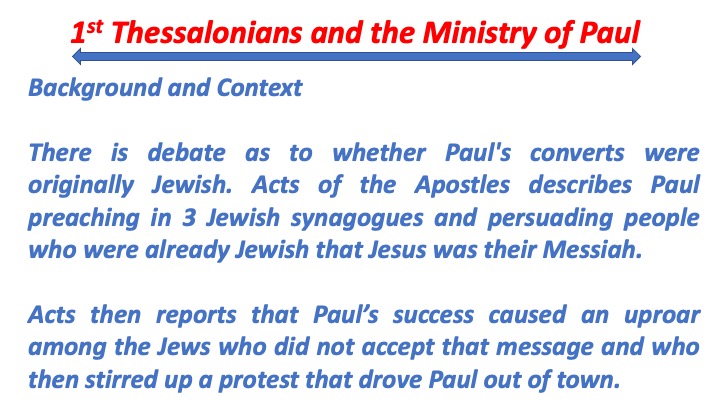



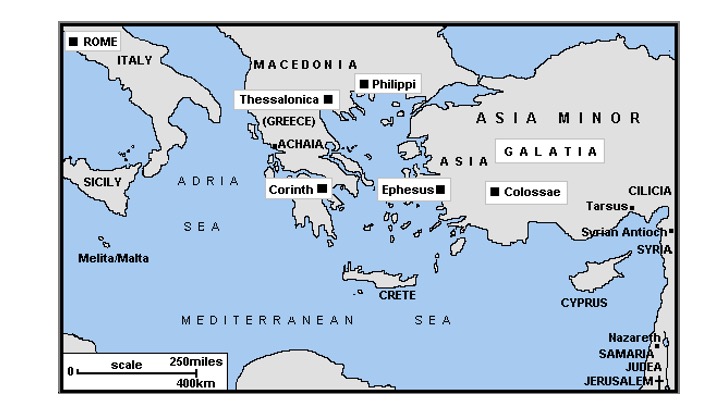

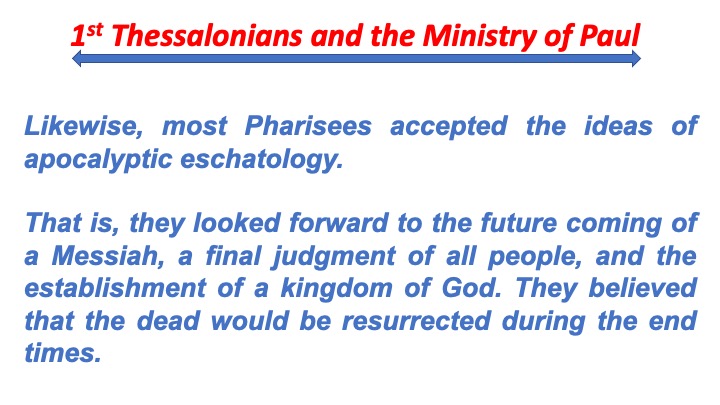

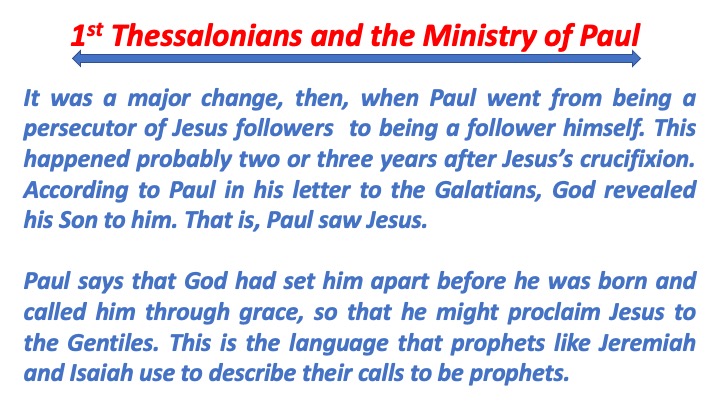

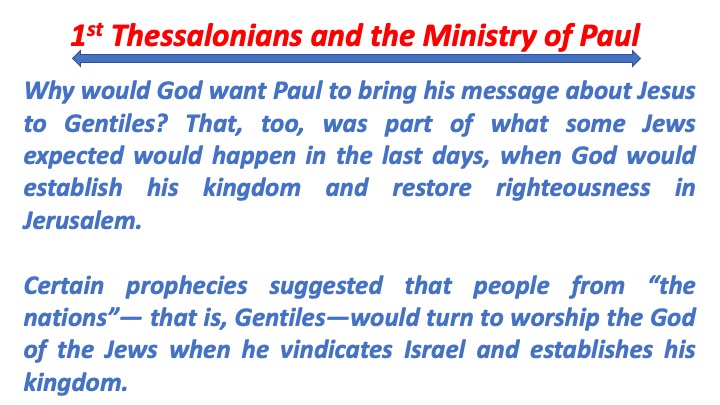

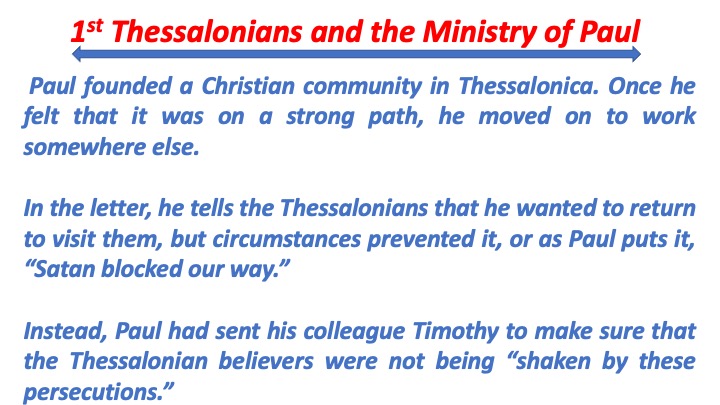
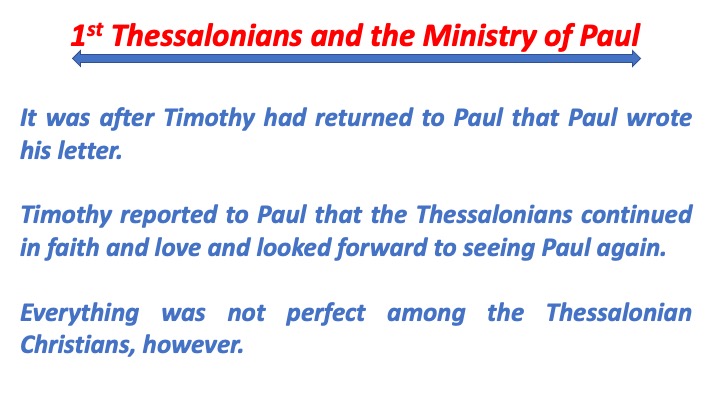

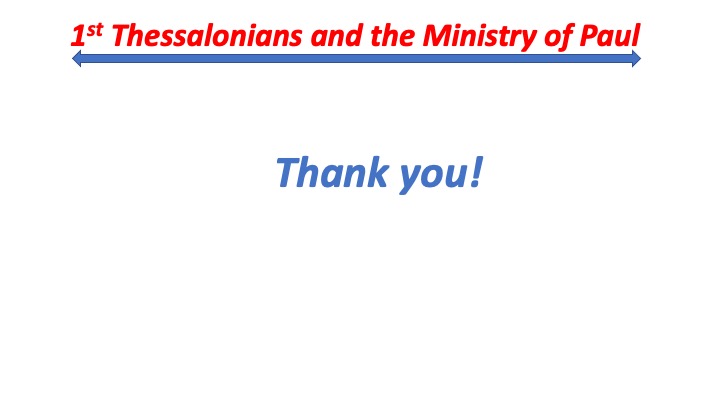
1st Thessalonians and the Ministry of Paul
TEXTS OF THE SLIDES
General Introduction – This Year
This year I will be teaching on several related topics.
1. 1st Thessalonians and Paul’s Ministry (Now)
2. Luke-Acts and the History of Salvation (4/16 – 4/23)
3.The Community of John After the Gospel (5/7 – 5/14)
4.Luke’s Inclusive Message (7/2 – 7/9)
5.Gospel of Mark – Jesus as the Suffering Son (8/13 – 8/20)
6.Gospel of Matthew – Jesus as the new Moses (11/12 – 11/19)
So How Are These Subjects Related?
There has been a significant shift in 20th & 21st century NT scholarship in trying to read our Bible in new ways. My generic term for this is reading the Bible thorough different lenses in order to learn new things. And more specifically, reading these documents as literature. But what does that mean?
Reading Bible Books as Literature.
Providing enough historical background and context regarding the times they were written and about the author to better understand why the author presented the story in the way that they did. They had a story they wanted to tell – why did they tell it that way?
In a combined Christian Perspectives /Dearman class in the summer of 2012 I devoted that summer to teaching an 11 week class on “Reading Genesis as Literature”. And since then I have done it a few more times on shorter subjects. As mentioned before I will do it 6 times this year. But each time only two weeks.
1st Thessalonians and the Ministry of Paul
The earliest piece of Christian literature that survives is Paul’s First Letter to the Thessalonians. It was originally written around the year 50, some 20 years after the crucifixion of Jesus - although the oldest copy of it that we have dates to the late 2nd century. Paul’s background, as well as the topics he chooses to address in 1st Thessalonians, give us insight into the history of early Christianity and the concerns of Jesus’s followers during this important period.
1st Thessalonians and the Ministry of Paul
Our sources of information about Paul consist of the letters attributed to him in the New Testament and the Acts of the Apostles. Acts is what historians call a secondary source. It was written as many as 70 years after Paul’s death, and it puts a particular spin on Paul’s ministry and his relations with other Christian leaders. But historians almost always rely more on primary sources, and the primary sources, to historians, are Paul’s letters.
1st Thessalonians and the Ministry of Paul
So, the letters of Paul are primary sources. But that presents its own problems, because they give us Paul’s view of himself and only occasionally convey what others thought about him - once again, from Paul’s perspective. Moreover, most historians do not think that Paul wrote all 13 of the New Testament letters that bear his name.
1st Thessalonians and the Ministry of Paul
Seven letters are recognized by all scholars as having been composed by Paul: Romans, 1st and 2nd Corinthians, Galatians, Philippians, 1st Thessalonians, and Philemon. If we want the most solid historical evidence for Paul’s life, we should rely on these. And in fact, we can learn a lot about Paul just from them.
Books or Documents?
We tend to call all of the epistles in the NT “books”. That is actually a little misleading. 1st Thessalonians is 3 pages long. Romans (Paul’s longest) is 13 pages. But 1st Thessalonians has attracted much attention by modern scholars. Why? Because it is our first report of what was happening in the early church.
1st Thessalonians and the Ministry of Paul
So how do we read 1st Thessalonians? Frankly, there is no easy answer. All through the history of biblical scholarship, scholars have read all these books in different ways, looking at the text through different lenses. We will be doing that in these two weeks.
Background and Context
Thessalonica is a city on the Thermaic Gulf, at the northern part of the Agean Sea which at the time of Paul was within the Roman Empire. Paul visited Thessalonica and preached to the local population, winning converts who became a Christian community.
Background and Context
There is debate as to whether Paul's converts were originally Jewish. Acts of the Apostles describes Paul preaching in 3 Jewish synagogues and persuading people who were already Jewish that Jesus was their Messiah. Acts then reports that Paul’s success caused an uproar among the Jews who did not accept that message and who then stirred up a protest that drove Paul out of town.
Background and Context
But in 1st Thessalonians itself Paul does not talk about that and instead says that the converts he had won over had turned from idols, suggesting that they were not Jewish before Paul arrived, but were Gentiles – pagans that worshipped idols.
1st Thessalonians and the Ministry of Paul
It’s important to remember that Paul the Apostle lived and died before any of the gospels that we have appeared. In fact, Paul would not have known he was a Christian, as the word did not exist yet.
Instead, he was a Jew who had been called by God’s Messiah, Jesus, to bring to Gentiles, non-Jews, the good news that Jesus would return soon to establish God’s kingdom.
1st Thessalonians and the Ministry of Paul
Paul was a Greek-speaking Diaspora Jew. That is, he was born and lived most of his life outside the traditional land of Israel, and he spoke and wrote in Koine Greek, which was the common language of the eastern part of the Roman Empire. Paul seems not to have known Hebrew, which means he would have read the Jewish Bible in a Greek translation. His quotations from the Old Testament do not always match our English translations from the Hebrew because he was quoting the Greek, probably from memory.
1st Thessalonians and the Ministry of Paul
In his letter to the Philippians and elsewhere, Paul reports that his family belongs to the tribe of Benjamin. More significantly, he says that he was a Pharisee with respect to the Law. From this we can suppose certain things about how Paul thought. For Example - The Pharisees were flexible in their interpretation of Jewish Law and of the Bible as a whole; they did not always stick to a strictly literal meaning of the text.
1st Thessalonians and the Ministry of Paul
Likewise, most Pharisees accepted the ideas of apocalyptic eschatology. That is, they looked forward to the future coming of a Messiah, a final judgment of all people, and the establishment of a kingdom of God. They believed that the dead would be resurrected during the end times.
1st Thessalonians and the Ministry of Paul
Paul did not call himself a prophet, however. He claimed to be an apostle. The word comes from the Greek apostolos, meaning “someone who has been sent”—that is, an envoy or representative. As Christ’s apostle, Paul had been sent by Christ to speak for him among Gentiles.
1st Thessalonians and the Ministry of Paul
Why would God want Paul to bring his message about Jesus to Gentiles? That, too, was part of what some Jews expected would happen in the last days, when God would establish his kingdom and restore righteousness in Jerusalem.
Certain prophecies suggested that people from “the nations” - that is, Gentiles - would turn to worship the God of the Jews when he vindicates Israel and establishes his kingdom.
It was Paul’s job to start gathering such righteous Gentiles and preparing them for the return of the Messiah.
1st Thessalonians and the Ministry of Paul
Paul tended to establish congregations in cities by the sea or along major trade routes. In such places, he could easily settle as one of the many people who came and went, and he could support himself through handiwork. Acts tells us that he made tents, which is entirely plausible. After Paul had moved on to a new city, he could dispatch colleagues to visit the places he had been and sometimes carry letters from him.
1st Thessalonians and the Ministry of Paul
Paul founded a Christian community in Thessalonica. Once he felt that it was on a strong path, he moved on to work somewhere else. In the letter, he tells the Thessalonians that he wanted to return to visit them, but circumstances prevented it, or as Paul puts it, “Satan blocked our way.” Instead, Paul had sent his colleague Timothy to make sure that the Thessalonian believers were not being “shaken by these persecutions.”
1st Thessalonians and the Ministry of Paul
It was after Timothy had returned to Paul that Paul wrote his letter. Timothy reported to Paul that the Thessalonians continued in faith and love and looked forward to seeing Paul again. Everything was not perfect among the Thessalonian Christians, however.
1st Thessalonians and the Ministry of Paul
And next week – we will get into what was not perfect! And see how Paul dealt with the persecutions faced by the early Thessalonian followers of Jesus! As well as some of their misunderstandings.
Come and Learn!